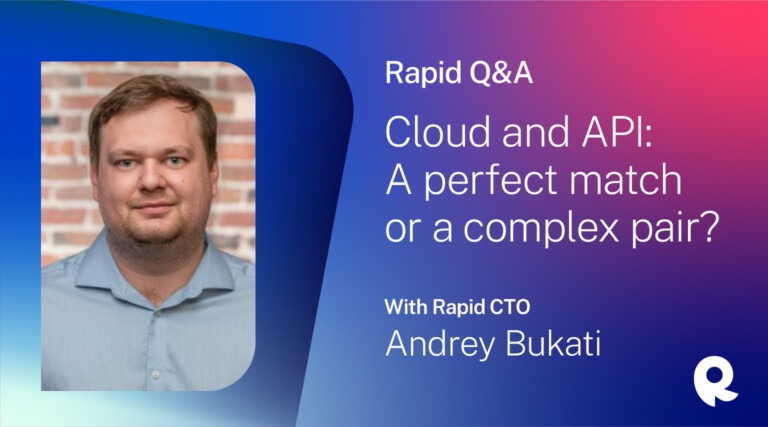The shift toward cloud-native architectures, as well as multi-cloud and hybrid cloud structures, has impacted the API economy in many ways. More and more companies have begun to move their infrastructure and applications to the cloud, which dramatically changes the way that APIs are created, deployed, and managed. At the same time, APIs are being recognized as critical solutions for streamlining and automating the process of interacting with cloud-based solutions.
To gauge what this all means for the DevOps community and what trends and opportunities we can expect to see in 2023, I recently sat down with Rapid CTO Andrey Bukati to get his take.
Let’s kick off with some background. Can you paint the picture for us of what’s behind this shift to cloud architectures? What is driving the widespread adoption of cloud, multi-cloud, and hybrid structures?
Andrey Bukati: I would start with an analogy to the automotive world. In the past, you had the car, the mechanics, and the media system—and all three were completely disconnected. Whatever you wanted to do with music or maps, for example, would be on the media side of the house, and everything pertaining to operating the car would be for the mechanics. Tesla broke this bridge between these worlds. In a Tesla, the media center controls everything, from the engine to the air conditioning and everything else.
Now we’re seeing the same thing in the software world, where historically the hardware and the software didn’t really speak to each other and now they are much more intertwined. In the cloud-native world, software is “aware” of the environment in which it functions. This equips the software, via APIs, with capabilities such as tracking resource consumption and “reacting” accordingly. If allocated resources are insufficient, for example, the software can request more resources or halt the execution of non-essential or less essential tasks to ensure a more efficient distribution of resources. This is true not only for the initial run, but for the actual scale of the software, which means that companies will no longer end up over-provisioning their resources.
What’s the impact of this shift in terms of productivity?
Andrey Bukati: This approach is far more effective as it boosts productivity because you’re planning the strategy of how things will be done, rather than simply being tactical about making the decision right away when things happen. With the shift to cloud native, many, many functionalities are now offered as APIs, and even further yet, as development kits. This means tools are actually integrated within the software that enable you to complete various tasks which previously were done manually, such as managing the infrastructure from within the software.
These three actions, for example, can now be done automatically via API:
- Creating an S3 bucket on AWS when a new customer signs up
- Changing security settings on the infrastructure (such as IP whitelisting) based on user preferences within the application
- Switching instances types according to real-time resources consumption
What has this all meant for the API economy?
Andrey Bukati: Cloud architectures make it faster and cheaper to spin up APIs, so this shift has been a larger factor in the growth of the API economy. The shift to cloud has also enabled companies to deploy their APIs around the world, which has increased their popularity and availability.
In addition, the API boom has helped companies use cloud architectures more efficiently. With APIs, organizations can effectively automate many tasks around interacting with and maintaining cloud-based solutions, including communicating with cloud storage services and assisting with management, automation, integration, and monitoring capabilities.
On the downside, increasing complexity within the API economy has been one challenging result of this shift. Can you share some thoughts on what’s happening there and how developers and companies are adapting?
Andrey Bukati: Yes, this shift to cloud structures has not only increased the total number of APIs, but also the number of APIs performing critical functions required for cloud storage to run properly. And in 2023, we will continue to see an explosion of APIs to support these new cloud architectures. Also, the increase of AI-based tools that have joined into the mix pose exciting opportunities, but also lead to increased complexity within the API world.
As a result, the DevOps community is feeling pressure to understand both the applications and solutions they are building as well as the engineering that goes on behind the scenes. In essence, there’s a narrowing gap between DevOps and software engineers.
The proliferation of APIs and their increased scalability in cloud-native environments also generates greater complexity. Scaling APIs requires companies to navigate increased loads during traffic spikes or other unexpected events, for instance. And the overall increase in the number of APIs being used in development makes it more complex to manage and maintain.
So will companies need greater DevOps manpower to handle this complexity?
Andrey Bukati: Yes. It is crucial for companies to understand that integrating and maintaining a large—and likely increasing—load of APIs requires skilled developers who can understand and manage this complexity. For their part, developers will need to expand their understanding of the ways in which APIs and cloud solutions are intertwined. They will be expected to handle, manage, and even predict the coming complexities.
So what’s next? What trends do you expect to see in 2023 and beyond?
Andrey Bukati: I believe we will see two trends gaining traction in 2023. The first has already started and will continue: providers like Vercel and Netlify are running on big cloud provider infrastructure in order to provide a niche product for a specific use case. This will enable faster development.
Second is that companies will turn to AI to help analyze cost impacts including computing, storage, and network resources as well as service, usage, and maintenance. I think we will see a crop of new products that use AI to help optimize costs for cloud structures and solutions.

Leave a Reply